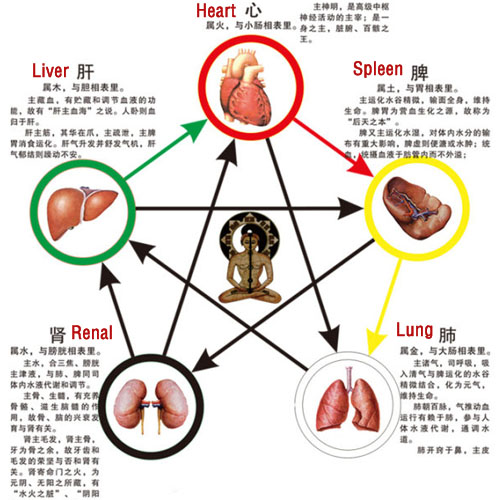Since the five zang-organs pair with the five elements, the five colors, the five flavors and the five pulses respectively, and because the disorders of the internal organs can manifest on the surface of the body, clinically the theory of the five elements can be used to analyze the changes of complexion, taste and pulse in order to decide which viscus and meridian are involved.
Diagnosis according to complexion, taste and pulse
The five colors, the five flavors and the five pulses correspond to the liver, the heart, the spleen, the lung and the kidney respectively. So they can be directly used to diagnose disease. For example, bluish complexion, preference for sour flavor or sour taste in the mouth and taut pulse indicate liver disease; reddish complexion, bitter taste in the mouth and full pulse indicate heart disease; yellowish complexion, sweet taste in the mouth and slow pulse indicate spleen disease; whitish complexion, acrid taste in the mouth and floating pulse indicate lung disease; and blackish complexion, salty taste in the mouth and deep pulse indicate kidney disease.

Deciding the Transmission of Disease According to Complexion, Taste and Pulse
If the complexion, taste and pulse of the patient do not agree with the nature of visceral disorder, it shows that the disorder is already changed among the five zang-organs. Then the theory of the five elements must be used to analyze the transmission. Take spleen deficiency for example. Instead of displaying the manifestations of yellowish complexion, sweet taste in the mouth and slow pulse, there are signs of bluish complexion, sour taste in the mouth and, taut pulse which are normally the manifestations of liver disorder. It shows that liver disease has been transmitted to the spleen, i.e. wood over restraining earth.
Take lung disease for another example. Instead of displaying the manifestations of whitish complexion, acrid taste in the mouth and floating pulse, there are signs of reddish complexion, bitter taste in the mouth and full pulse which are normally the manifestations of heart disease. It shows that heart disease has been transmitted to the lung, i.e. fire over restraining metal.
Of course, using the theory of the five elements to diagnose disease is only one of the methods used in clinical diagnosis. In order to reveal the nature of disease and make correct diagnosis, this method should be used together with other methods for differentiation of syndrome, such as yin and yang, zangxiang (visceral and their manifestations), qi, blood and body fluid.







